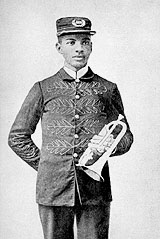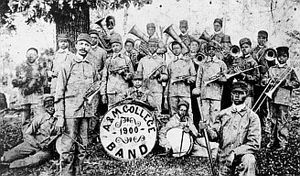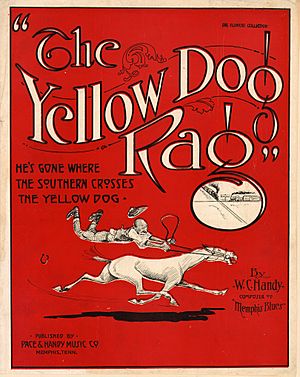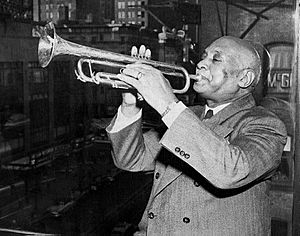W. C. Handy facts for kids
Quick facts for kids
W. C. Handy
|
|
|---|---|
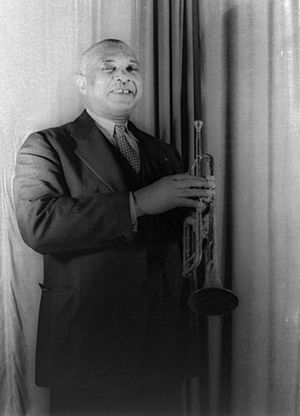
Handy in July 1941, photographed by
Carl Van Vechten |
|
| Background information | |
| Birth name | William Christopher Handy |
| Also known as | Father of the Blues |
| Born | November 16, 1873 Florence, Alabama, United States |
| Origin | Memphis, Tennessee, United States |
| Died | March 28, 1958 (aged 84) New York City, New York, United States |
| Genres | Blues, jazz |
| Occupation(s) |
|
| Instruments | Trumpet |
| Years active | 1893–1948 |
William Christopher Handy (born November 16, 1873 – died March 28, 1958) was an American composer and musician. He called himself the Father of the Blues. Handy was one of the most important songwriters in the United States.
Many musicians played the unique American blues music. Handy did not invent the blues. But he was the first to publish blues music. This helped the blues grow from a local style to become very popular. Handy was a trained musician. He used parts of folk music in his songs. He carefully wrote down where his music ideas came from. His songs often mixed styles from different performers.
Contents
Handy's Early Life
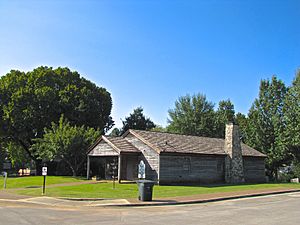
William Christopher Handy was born in Florence, Alabama. His parents were Elizabeth Brewer and Charles Barnard Handy. His father was a pastor at a small church. Handy wrote in his book Father of the Blues that he was born in a log cabin. His grandfather built the cabin.
Handy's father thought musical instruments were bad. Handy secretly bought his first guitar. He saved money by picking berries and making soap. When his father saw the guitar, he was upset. He told Handy to take it back. But his father also arranged for him to take organ lessons. Handy later learned to play the cornet. As a teenager, he joined a local band. He kept this a secret from his parents.
Growing up, he learned carpentry, shoemaking, and plastering. He was very religious. Church music and nature sounds influenced his musical style. He said that sounds from birds and animals inspired him. He also mentioned the sounds of Cypress Creek.
He worked on a "shovel brigade." There, workers would hit their shovels to make music. Handy said these rhythms were "better than a drum corps." He remembered this as a key moment for his music. He said Southern Black people sang about everything. They used anything to make musical sounds. This helped create what we now call the Blues.
Handy's Music Career
Starting Out in Music
In 1892, Handy went to Birmingham, Alabama. He passed a teaching exam easily. He got a teaching job at Teachers Agriculture and Mechanical College. This is now Alabama A&M University. He quit because the pay was low. Then he worked at a pipe factory.
In his free time, he started a small orchestra. He taught musicians to read music. Later, he formed the Lauzetta Quartet. They wanted to go to the World's Fair in Chicago. They did odd jobs to earn money. They arrived in Chicago, but the Fair was delayed. They went to St. Louis, Missouri, but found no work.
The quartet broke up. Handy went to Evansville, Indiana. He played the cornet at the Chicago World's Fair in 1893. In Evansville, he joined a successful band. They played in many cities. Handy did many musical jobs. He sang, directed bands, and played cornet. At 23, he became the bandmaster for Mahara's Colored Minstrels.
They toured for three years. They went to Chicago, Texas, Oklahoma, Tennessee, and even Cuba and Canada. Handy earned $6 a week. After returning from Cuba, he and his wife, Elizabeth, stayed with family in Florence.
Handy met Elizabeth Price in 1896. They married on July 19, 1896. Their first child, Lucille, was born in 1900. Around that time, Handy was hired to teach music. He taught at State Agricultural and Mechanical College for Negroes. He was a faculty member from 1900 to 1902. He was unhappy because the college focused on European classical music. He felt he was underpaid. He thought he could earn more touring with a minstrel group.
Developing the Blues Style
In 1902, Handy traveled through Mississippi. He listened to many kinds of popular Black music. Mississippi was mostly rural. Music was a big part of the culture, especially on cotton plantations. Musicians often played guitar or banjo. Handy had a great memory. He could remember and write down the music he heard.
Handy left his teaching job. He went back to the Mahara Minstrels. In 1903, he led a Black band in Clarksdale, Mississippi. Handy and his family lived there for six years. During this time, he had important experiences that shaped his music. In 1903, he heard a Black man playing a steel guitar with a knife. This was in Tutwiler, Mississippi.
Around 1905, Handy played a dance in Cleveland, Mississippi. Someone asked for "our native music." Handy played an old Southern song. Then, a local Black band played. Handy agreed. Three young men with old instruments played. This band was led by Prince McCoy.
Handy also learned from square dances held by Black people in Mississippi. These dances often used the G major key. He used this key for his famous 1914 song, "Saint Louis Blues."
First Big Hit: "The Memphis Blues"
In 1909, Handy and his band moved to Memphis, Tennessee. They played in clubs on Beale Street. "The Memphis Blues" was first a campaign song. It was for E.H. Crump, a successful Memphis mayoral candidate. Handy later rewrote the song. He changed its name from "Mr. Crump" to "Memphis Blues."
The sheet music for "The Memphis Blues" was published in 1912. It showed his 12-bar blues style. This song inspired the foxtrot dance. Handy sold the rights to the song for $100. By 1914, at age 40, he had a clear musical style. His popularity grew a lot. He wrote many songs.
In his book, Handy explained how he used Black folk music in his style. Blues music uses three main chords. It also uses blue notes. These came from music made by poor Southern Black people. His usual three-line song structure came from a song he heard. He changed it to: "make a statement, repeat it, then explain it." He also left spaces for singers to add their own parts. This was common in folk blues.
His published music was special because of his race. In 1912, he met Harry Pace. Pace was a smart businessman. Handy liked him. Pace later became the manager of Pace and Handy Sheet Music.
In 1916, composer William Grant Still worked for W.C. Handy's band. In 1918, Still joined the United States Navy. After the war, he worked for Handy again in Harlem.
Moving to New York
In 1917, Handy moved his publishing business to New York City. His office was in Times Square. By the end of that year, his most famous songs were published. These included "Memphis Blues," "Beale Street Blues," and "Saint Louis Blues."
That year, the Original Dixieland Jass Band, a white jazz group, made the first jazz record. This introduced jazz to many Americans. Handy did not love jazz. But bands eagerly played his songs. Many of his songs became jazz standards.
Handy helped performers like Al Bernard. Bernard was a white man who sang blues powerfully. Handy sent Bernard to Thomas Edison to record. This led to many successful recordings. Handy also published music by other writers. His business became known for publishing Black music.
In 1919, Handy signed a contract with Victor Talking Machine Company. They recorded his 1915 song "Yellow Dog Blues" again. This recording sold hundreds of thousands of copies.
Handy tried to get Black singers interested in his music. But many musicians preferred to play current hits. Handy said white bandleaders were more open to new music. Handy also had trouble selling songs to Black women singers. But in 1920, Perry Bradford convinced Mamie Smith to record two non-blues songs. Handy published them. When Bradford's "Crazy Blues" became a hit, Black blues singers became popular. Handy's business faced more competition.
In 1920, Pace left his partnership with Handy. Pace started Black Swan Records. Many employees went with him. Handy continued his publishing company as a family business. He published his own songs and those of other Black composers. He wrote over 150 religious songs and folk song arrangements. He also wrote about 60 blues songs.
In the 1920s, he started the Handy Record Company. This label did not release records. But Handy organized recording sessions. Some of these recordings were released on other labels. "Saint Louis Blues" was so successful that in 1929, Handy made a movie of the same name. He suggested blues singer Bessie Smith for the main role. The movie was shown in theaters from 1929 to 1932.
Handy's work influenced European composers. For example, Maurice Ravel was inspired by Handy. Ravel wrote his famous "Blues sonata" for violin and piano after Handy visited Paris.
In 1926, Handy wrote Blues: An Anthology. This book tried to record and describe the blues. It showed the blues as a key part of American history. A party was held in Harlem to celebrate the book and honor Handy.
Later Life and Passing
In 1938, a radio show called Ripley's Believe It or Not! called Handy "the father of jazz as well as the blues." Another blues musician, Jelly Roll Morton, disagreed. He wrote a letter saying he invented jazz.
After his autobiography, Handy published Unsung Americans Sung (1944). This book was about African-American musicians. He also wrote three other books about blues and Black composers. He lived in Harlem. He became blind in 1943 after a fall.
From 1943 until his death, he lived in Yonkers. His first wife died. In 1954, at age 80, he remarried his secretary, Irma Louise Logan. He often said she became his eyes. In 1955, he had a stroke and used a wheelchair. Over 800 people attended his 84th birthday party.
W. C. Handy died on March 28, 1958, from pneumonia. He was 84 years old. Over 25,000 people attended his funeral in Harlem. More than 150,000 people gathered outside the church. He was buried in Woodlawn Cemetery in the Bronx.
Handy's Compositions
Handy's music sometimes does not follow the classic 12-bar pattern. It often has 8- or 16-bar parts between 12-bar sections.
- "Memphis Blues" (1909, published 1912).
- "Yellow Dog Blues" (1912). This song mentions the "Yellow Dog" railroad.
- "Saint Louis Blues" (1914). This is a very famous blues song.
- "Loveless Love."
- "Aunt Hagar's Blues."
- "Beale Street Blues" (1916). This song was a goodbye to Beale Street in Memphis. The street was renamed because of the song's popularity.
- "Long Gone John (from Bowling Green)."
- "Chantez-Les-Bas (Sing 'Em Low)." This song honors the Creole culture of New Orleans.
- "Atlanta Blues."
- "Ole Miss Rag" (1917). This is a ragtime song.
Awards and Honors for W. C. Handy
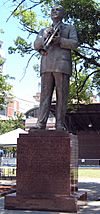
- Handy was the subject of a movie called St. Louis Blues (1958). Nat King Cole played Handy.
- W.C. Handy Place in New York City is the honorary name for 52nd Street.
- In 1969, the United States Postal Service made a stamp to honor him.
- He was put into the National Academy of Popular Music Songwriters Hall of Fame in 1970.
- He was put into the Nashville Songwriters Hall of Fame in 1983.
- He was put into the Alabama Jazz Hall of Fame in 1985. He also received an award from the Alabama Music Hall of Fame in 1993.
- He received a Grammy Trustees Award for his lifetime achievements in 1993.
- In 2002, the U.S. Senate declared 2003 the "Year of the Blues." This was to celebrate 100 years since Handy composed the first blues music.
- Handy was honored with two markers on the Mississippi Blues Trail. One is in Clarksdale, Mississippi. The other is at his birthplace in Florence, Alabama.
- The Blues Music Award was called the W. C. Handy Award until 2006.
- The W. C. Handy Music Festival is held every year in Florence, Alabama.
- In 2017, his book Father of the Blues was added to the Blues Hall of Fame.
- Handy Park in Memphis, Tennessee, was named after him in 1931. It has a stage for music. A large bronze statue of Handy is in the park.
Images for kids
See also
 In Spanish: W. C. Handy para niños
In Spanish: W. C. Handy para niños


